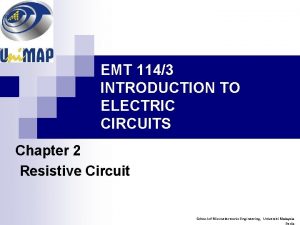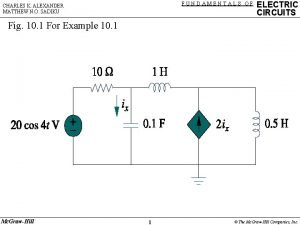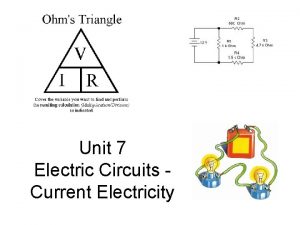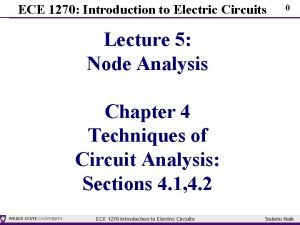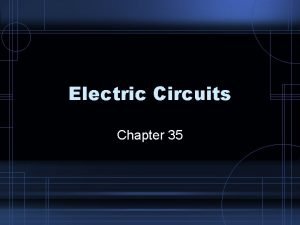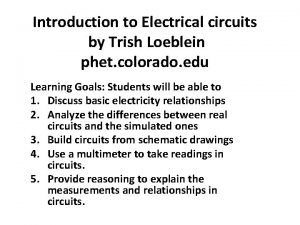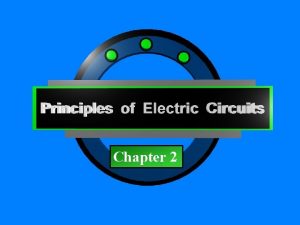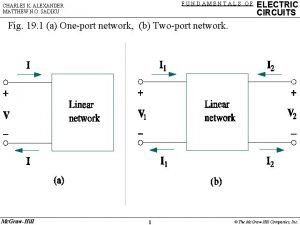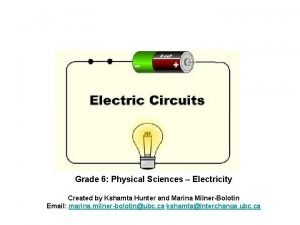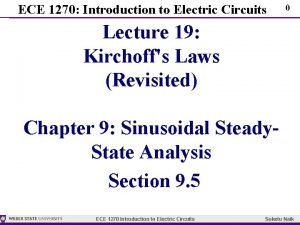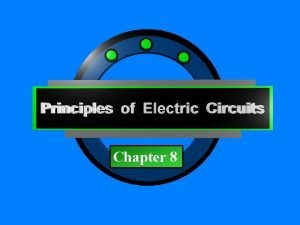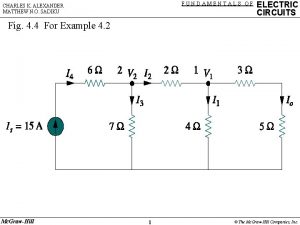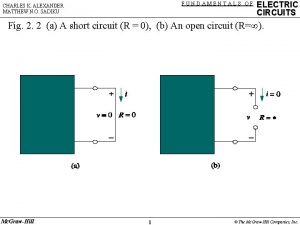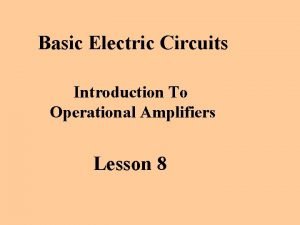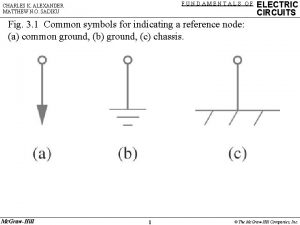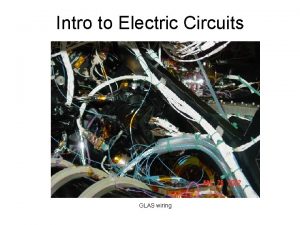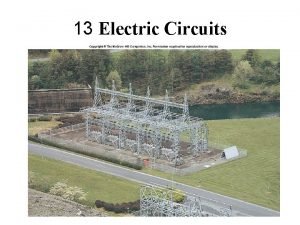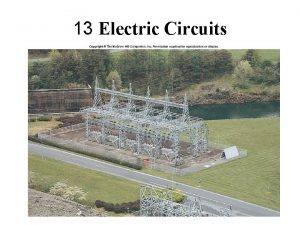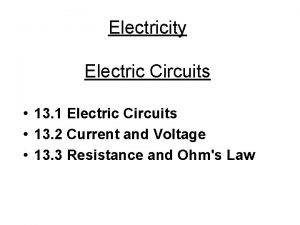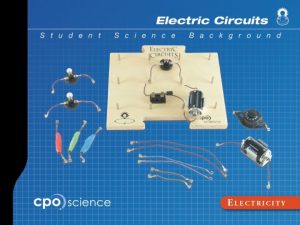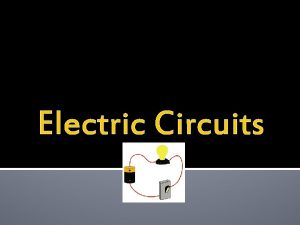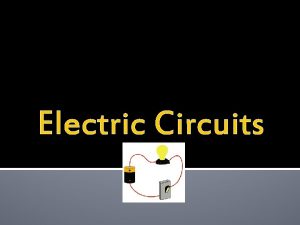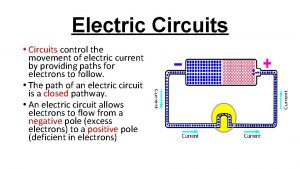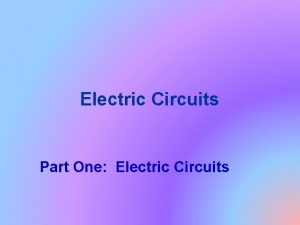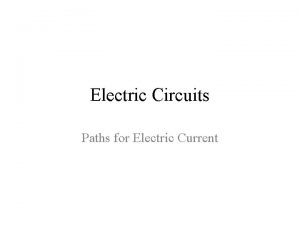Electric Circuits continued Electric Circuits There are 3



























- Slides: 27

Electric Circuits (continued)

Electric Circuits • There are 3 parts to any Electric Circuit: 1. Energy Source 2. Energy Conductor 3. Energy Receiver

Energy Source Energy Receiver(resistance) Energy Conductor

In order to work properly, electricity has to get : 1. To the device 2. Through the device 3. And back to the other side of the battery(or outlet)

Open Switch • Electricity can’t move through. • Device will not work properly!! • Called an Open Circuit!! Closed Switch • Electricity can move through. • Device will work properly. • Called a Closed Circuit!!

Before you move on, remember a couple of things: 1. Voltage determines whether electricity flows or not!! 2. Resistance determines how much!! Discuss the dimmer switch they forgot to use in that Hotel!!

2 Types of Electric Circuits: Series Circuit • Current has only one path to take. • All of the current will travel through each device. • “Cheap” Christmas tree lights. Parallel Circuit • Current has more than one path to take. • All of the current will not travel through each device. • “Expensive” Christmas tree lights.

Series Circuit: In a series circuit, if one of the lights goes out, what happens to the remaining light(s)? Hence, the “Cheap lights”!

Parallel Circuit In a parallel circuit, if one light goes out, what happens to the remaining lights? Hence, the “Expensive lights!!

Remember this: Because Stone Cold Said So!!! What determines whether electricity will or will not flow? Voltage What determines how much electricity flows? Resistance

Voltage in Series There are 3 different places that the river in this picture “drops”. Voltage is highest at V 1!! It gets there first!!! If you want to know the total “drop” in the river, you simply add up the separate “drops”!! Same with Electricity!!!! They do drop the same amount!!

12 V Loses 4 V The Voltage drops some as it passes through each resistor!! Loses 4 V Each light will lose the same Voltage and if each has the same resistance, they will each light up with the same brightness!! But what happens if you add more lightbulbs?

As you continue to add lights, they will get dimmer and dimmer!! WHY? ? ? ?

Why do lights get dimmer as you add more of them to a series circuit? • As you add more light bulbs, the resistance gets bigger and bigger!! • As resistance gets bigger and bigger, current gets smaller and smaller. • Remember, less current= less brightness!!!

Voltage in Parallel This river has 3 different branches!! They all follow different paths, but when they join back together, how much has each of them “dropped”? The Same Amount Same with electricity!!!

12 V Total Voltage Therefore, the voltage along any of the paths is 12 V. If the light bulbs all have the same resistance, the Current through each will be the same!! Each light will “light up” with the same brightness! What if you add more bulbs?

1 Bulb Notice the brightness! 2 Bulbs Notice the brightness! 3 Bulbs Notice the brightness! 4 Bulbs Notice the brightness!

Because each branch of a parallel circuit has the same voltage, if the light bulbs have the same resistance, the same amount of current will flow through each. They will always be the same brightness!! WHY? ? ?

Why do lights NOT get dimmer as you add more of them to a parallel circuit? • As you add more light bulbs, the resistance actually gets smaller and smaller. • As resistance gets smaller and smaller, current gets larger and larger. There’s more of it. • Enough to go to that other path without changing the brightness!!

A B C


A B C


A B C


Series vs. Parallel Circuits

Study Island • Go to www. studyisland. com • Login and proceed through the Electric Charge and Circuits lesson.
 Antigentest åre
Antigentest åre Current in a parallel circuit
Current in a parallel circuit Introduction to electric circuits
Introduction to electric circuits 9
9 Quarturs
Quarturs Sadiku
Sadiku Ohm's law calculations worksheet
Ohm's law calculations worksheet Conceptual physics chapter 35
Conceptual physics chapter 35 Physics reference table
Physics reference table Elec 202
Elec 202 Find vx
Find vx Fundamentals of electric circuits chapter 7 solutions
Fundamentals of electric circuits chapter 7 solutions Basic electrical engineering kulshreshtha
Basic electrical engineering kulshreshtha Chapter 35 electric circuits
Chapter 35 electric circuits Phet electric circuits
Phet electric circuits Principles of electric circuits
Principles of electric circuits Alexander
Alexander Chapter 20 electric circuits
Chapter 20 electric circuits Kshamta hunter
Kshamta hunter Ece
Ece Chapter 35 electric circuits answers
Chapter 35 electric circuits answers Principles of electric circuits 10th edition answer key
Principles of electric circuits 10th edition answer key Fundamentals of electric circuits chapter 4 solutions
Fundamentals of electric circuits chapter 4 solutions Fundamentals of electric circuits
Fundamentals of electric circuits Electrical circuit elements
Electrical circuit elements Alexander and sadiku
Alexander and sadiku Electric circuits equations
Electric circuits equations Charles k. alexander matthew n. o. sadiku
Charles k. alexander matthew n. o. sadiku


